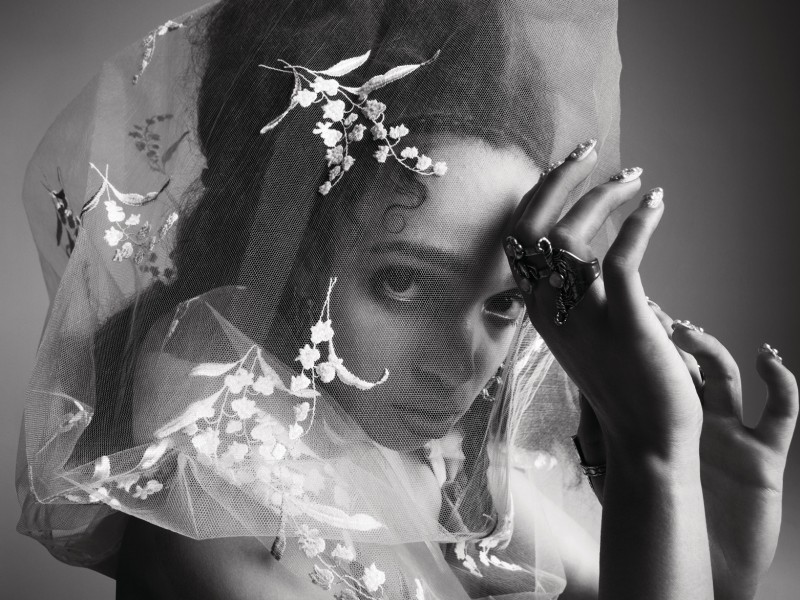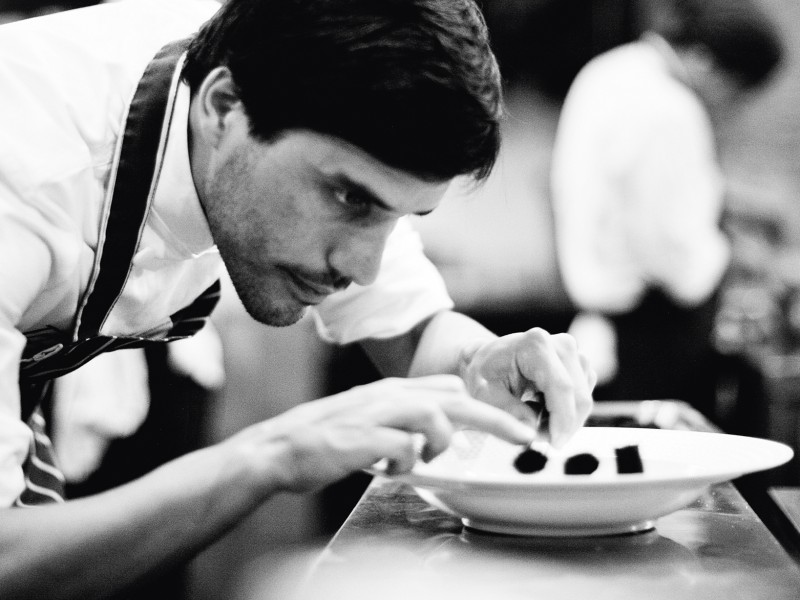In his 2013 production Karl Lagerfeld se dessine, French documentary filmmaker Loïc Prigent positions his camera over Lagerfeld’s shoulder and during the course of 49 minutes asks the 80-year-old designer to draw key moments of his life. To Prigent’s request, can you draw me your childhood home? Lagerfeld’s fingerless-gloved hand steers a thick black marker across an ivory sketchpad to conjure up the two-storey, 1900s house 40 kilometres north of Hamburg in which he was raised. Under a lyrically pitched roof, he places his bedroom at the front next to his father’s dressing room—both overlooking a majestic circular drive. He outlines a horned stag’s head above the door to evoke the wildlife of the 3,000-hectare park in which the house reputedly sat.
Alluding to the now infamous International Wool Secretariat Prize of 1954 in which 21-year-old Lagerfeld and 18-year-old Yves Saint Laurent both won prizes, thus inaugurating one of the fashion world’s most notorious rivalries, Prigent asks, can you draw me Yves Saint Laurent? “Thin, thin, thin, but the funniest most outrageous boy you could imagine,” Lagerfeld narrates as he outlines Saint Laurent’s square-framed eyewear perched atop a beak-like nose. “Nothing like the man [Pierre] Bergé would make of him later.”
The love of his life, Jacques de Bascher who he met in Paris in 1979? “Jacques was Jacques. He looked like a soldier from the 1940s, lacquered hair, moustache. He was quite simply the chicest Frenchman I had ever seen.”
In a final gambit, Prigent asks Lagerfeld to draw the place where he would like to be buried. “The what?” Lagerfeld balks, genuinely—viscerally—thrown. Prigent repeats, could you draw the place that you would like to be buried?
“Oh mais quelle horreur, mais alors ça!” (He rips a page out of his sketch book, folds it and prepares to throw it away.) “Brulé, jêté, fini!” (It’s uncertain at first whether he’s referring to the question which he would like ‘burnt, thrown away, finished’—or to his corpse.) Then with a faint, slightly mercurial smile Lagerfeld recovers his legendary sangfroid. “When it’s time to go you have to go, to disappear. I’m against memory. I admire the animals of the forest who go away to die. The idea of imposing ones remains on society leaves me cold.”
“It’s difficult to say what scares Karl because he’s not someone who dwells on things,” says Prigent, who has also made documentaries about Marc Jacobs, Sonia Rykiel and Alexander McQueen. “Karl’s not a soul-searcher. But if one thing scares him it’s perhaps those people who refuse to adjust to the times, who for whatever reason reject progress, who resist adapting to new conditions. He puts it really well: ‘If you don’t adapt to the times it’s not the times that will adapt to you and you will be left like an old relic by the side of the road.’ I’m paraphrasing what he would certainly say in a more scathing, but also more real, manner.”
Lagerfeld’s career spans six decades and as many brands, most notably Chloé, Fendi and Chanel which he has helmed since 1983, eleven years after the death of Mademoiselle left it covered in déclassé dust. Privately owned by Alain and Gérard Wertheimer, progeny of the visionary tycoon who floated Coco Chanel’s fragrance Nº5 in 1924 thus founding today’s giant Parfums Chanel group, the company is not obliged to disclose its profits but Forbes estimates its worth, as of May 2017, at US$7.3 billion. The Wertheimer’s wealth is very directly attributable to Lagerfeld’s tireless drive: he works quite literally all the time. As for his own wealth, he confesses to not even knowing himself. His value, on the other hand, he understands only too well.
It derives in equal parts from an astonishing intellect, an insatiable curiosity and an absolute aversion to nostalgia. Under Lagerfeld’s watch Chanel has become the most famous fashion brand on the planet—precisely because he treats it irreverently. He’s more likely to take inspiration from space travel or shipping containers or Daft Punk than he is from the Belle Époque; to set his Chanel shows in a grocery store or a wind farm or a NASA launch pad. Indefatigable, he works the brand’s DNA like a mad geneticist.
I first met Lagerfeld when he was fat. It must have been 1998 or 1999, in any case before Hedi Slimane took over Dior Homme in the middle of 2000. I would have been interviewing him for Numéro, the magazine I was editing at the time. Later, for Numéro’s centennial 1999/2000 issue, I asked Lagerfeld if he would shoot a series of ten still lifes—ten objects from his personal furniture collection to represent the style of each decade of the preceding one hundred years. It was an intense process involving many late nights roaming about his 18th century hôtel particulier at 51 rue de l’Université, often batting away the naked boys he’d had shipped in to drape themselves across a Jean-Michel Frank console from the 1930s or soak seductively in a Droog designed bath from the 1990s. (I always felt the enlisting of the muscle boys was more for my amusement than his; Lagerfeld happily pointed out his own single bed with its pale coral coloured satin sheets.)
It was while hunting for the nearest bathroom in the labyrinthine two-storey mansion that I stumbled across a small room filled with a complete collection of child-sized Biedermeier furniture—a bed, a desk, an assortment of consoles scattered across the parquet de Versailles floor. On the wall, a small pastoral oil painting. “It’s the first piece of art I ever acquired as a child,” Lagerfeld informed me when I rejoined him, surprised but not embarrassed that I’d stumbled across his cache.
Biedermeier was the style of furniture favoured by the aspirational middle classes of Mitteleuropa, a product of the era when the refined decorative arts of the Habsburg dynasty began to trickle down to common sensibilities. Yet Lagerfeld always claimed to be of the aristocracy, a true blue blood, the offspring of a noble father and an artiste mother, who moved to Paris on his own aged 14. Something didn’t seem quite right, but in the meantime the naked boys were cavorting and Lagerfeld was about to go on a diet that would see him lose 42 kilos in just over a year. Determined to fit into the New Look ultra-skinny suits being sent out by Slimane at Dior Homme, during lunches at home on the rue de l’Université the majordomo would slip Lagerfeld his daily poached chicken breast while guests were regaled with foie gras courtesy of two private chefs. “I want to show I am in control of my body,” he said at the time.
Lagerfeld likes to be in control of his image. In 2006, former contributing editor to W and British Vogue, Alicia Drake released The Beautiful Fall: Fashion, genius and glorious excess in 1970s Paris. A detailed examination of the personal histories and flamboyant rivalries of Lagerfeld and Saint Laurent, Drake takes a sledge hammer to the Lagerfeld myth which had been painstakingly built up with Gitanes-smoke and disco mirrors over decades. For Lagerfeld it was what he perceived as the author’s slight to his class origins that hurt the most. In a letter to Drake, published by Women’s Wear Daily on September 12, 2006, Lagerfeld decried the “100 mistakes and more” in the book, but most notably rankles at what he believes is her assertion that he lived a “grey, grey boring middle-class life”. Lagerfeld didn’t sue Drake or her publisher, but he did manage to have the book banned in France—where it remains unavailable to this day.
And yet, one of the great services The Beautiful Fall did for Lagerfeld was bring Jacques de Bascher into the public sphere. For years, rumours had circulated about the one man in Lagerfeld’s life, but accounts were amorphous, the figure refused to come into focus. We now know de Bascher was a player (even the particule ‘de’ which denotes noblesse was a fake), with his sights set on the kind of glamorous life an independently wealthy, irremediably worldly man like Lagerfeld could provide. Lagerfeld’s weakness serves to humanise a public figure who can tend in the popular psyche to take on the stature of an omnipotent demiurge.
In fact, Karl Lagerfeld is incredibly human, constantly pulling the rug out from under his own supposedly elite feet. Fun facts from the public record: Karl Lagerfeld has never adopted French citizenship (“I’m a kraut, can’t change that!”) and has never voted in his life. He’s worn high-collared shirts since he was a child, but the Hilditch & Key shirts he favours today button up the back—a signal to those in the know that he has a butler. Last summer in Provence he had Passionfruit by Drake (not the American writer, the Canadian rapper) on a loop in his convertible. He’s a master at Latin ballroom dancing with a particular proclivity for the cha-cha.
“What always amazes me about Karl is that whenever I see him—bumping into him by chance, interviewing him or observing him with others—he has this unflagging sense of humour,” says Prigent. “He is constantly making jokes! He draws caricatures absolutely non-stop, makes crazy word-play absolutely non-stop, riddles around absolutely non-stop. He is able to recount hysterical anecdotes concerning a Russian princess a hundred year ago as readily as a scandal that occurred the night before at The Ritz. He makes jokes about current affairs, about history, but also about what’s going on right under his nose in his own studio, in the street, in the papers … Spending time with Karl is a guarantee that you’ll laugh about all manner of foibles at all manner of different levels of sophistication.” As Lagerfeld once put it: “Everything I say is a joke. I am a joke myself.”
For more visit www.karl.com
Related Features
-
197
-
-
-

